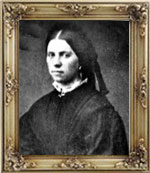|
Bodil (Bodild) Marie Jensen was born in Raadved, Skanderborg, Denmark (Some
researchers have Bodil's birth date as August 21, 1839 and have her birth place
as Horsens rather than Raadved. In 1861 she married Taylor Jensen. In 1864 Bodil
was traveling with one of the pioneer groups heading across the plains to Salt
Lake City, Utah. Since she was traveling without her husband, an assumption can be
made that he had passed away.
During the journey, Bodil met a man named Peter Jensen who was in the same party.
By the time they reached Nebraska, the couple had decided to be married, so
accordingly, on July 1st, the marriage was performed in Nebraska City. Bodil and
Peter arrived in Salt Lake City and were asked by Brigham Young to help the settlers
in Parowan, Iron County, Utah. Bodil would spend the next seventeen years there bearing
and raising a family of eight children in the Mormon community.
Bodil gave birth to her eighth child, Wilford (nicknamed Wiff) Augustus Jensen on May
14, 1881 in Parowan, Utah. She soon became deathly ill. The Jensen children always
remembered the last Christmas with their mother. Eight Jensen children, between the
ages of one and seventeen, gathered by the bed and they ate rice pudding which their
father had prepared for the occasion. Bodil died on the 19th of October, 1882 at the
age of forty three.
Bodell J Jensen and her parents are buried in Parowan, Utah. Ed and Clerynth
Larson located their graves. They have markers, or stones in good condition.
Written by Clerynth Jensen Larson, Granddaughter of Peter Jensen
PAROWAN
Peter and Bodil Jensen and their family settled in Parowan located in Southern
Utah and began farming. They stayed there until the water ran out. Parowan was first
inhabited by the Fremont and Anasazi Indians. Petroglyphics are still in evidence
featuring snakes, lizards, mouse-men, bear claws, and mountain sheep. In 1849, two
years after the early pioneers entered the Salt Lake valley, Brigham Young sent Parley
P. Pratt with a company of men to explorer southern Utah. They camped and erected a flag
pole at what is present day Parowan. The flag pole has survived to this day. The men
returned with a report that they had found "a hill of the richest iron ore" near present
day Cedar City. The Iron Mission, 250 miles away, was under way by the next summer.
The first presidency called for volunteers, but few came forward, so George A. Smith
of the Council of the Twelve Apostles, received permission to call others to go. In the
mist of a bitter winter, 120 men, 31 women, and 18 children made a difficult journey to
the south. On arrival, they circled the flag pole left by Pratt and thus began the
establishment of the Parowan community. By April, they had surveyed sixteen acres of
farm land, sowed a thousand acres of wheat, built roads, constructed a fort, and dug
wells
Many problems occurred in those early years. There was a great flood in 1853, An
Indian war erupted in 1854, called the Walker War. Brigham Young visited the
settlement in 1855 and the next year, 1856, began a devastating drought. In 1857,
Johnson's Army was on the way and 30,000 "Mormons" were forced to leave the Salt
Lake Valley and travel south as the army approached. Parowan sent teams and wagons
to help with the move. "The Utah War" was settled peacefully. That same year some
men from Cedar City and Parowan were involved in the "Mountain Meadow Massacre"
with Indians from the area. More than a hundred non-Mormons were slain. Some of the
Parowan residents moved away after this incident and a "spirit of disunity" prevailed
in the area.
The church purchased seven wagon loads of federal cannon balls, when Johnson's
soldiers traveled east to fight in the Civil War. They hauled them south and converted
them to "bells, stove parts, rollers to squeeze the juice out of sugar cane, and other
castings
The iron venture was never successful and was eventually abandoned in 1861. Several
years later, in 1864, Peter and Bodil Jensen arrived in Salt Lake City from Denmark
and they were sent to Parowan by Brigham Young to help the remaining saints there. In
the next sixteen years, Bodil gave birth to three daughters and five sons in Parowan.
One of the sons was Peter Andrew Jensen, who was born in 1867.
A Parowan Indian Tale
Although Parowan was prepared for Indian trouble and annoyed by petty thievery
and threats for some time, the settlement itself escaped depredations. One of its
folktales, however, centers on a band of Indians who demanded a sack of grain apiece
from Brother Davenport's meager harvest at threshing time. He countered by selecting,
from the threshing crew, Bob Quarm with a peg leg, Robert Miller with a curly red
wig, and Elder George A. Smith with his false teeth. "At a given
signal., Bob
Quarm gave a war whoop and unbuckled his peg leg and threw it in the air. Robert
Miller, not to be outdone, gave another war whoop and threw his wig in the air,
exposing his starry dome. The Indians stood wide eyed, but when George A. Smith
gave a howl and let his false teeth fall, they took to their horses and fled.
|
|
|


